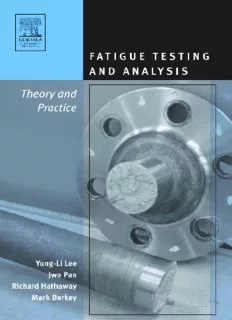Table Of ContentLEE:FATIGUETESTINGANDANALYSIS FinalProof 21.6.2004 6:19pm page i
Fatigue Testing
and Analysis
(Theory and Practice)
This page intentionally left blank
LEE:FATIGUETESTINGANDANALYSIS FinalProof 21.6.2004 6:19pm page iii
Fatigue Testing
and Analysis
(Theory and Practice)
Yung-Li Lee
DaimlerChrysler
Jwo Pan
Universityof Michigan
Richard B. Hathaway
WesternMichigan University
Mark E. Barkey
University of Alabama
. . . .
AMSTERD.AM BO.STON HEIDE.LBERG LONDON. NEW YORK
OXFORD PARIS SAN DIEGO . SAN FRANCISCO SINGAPORE
SYDNEY TOKYO
LEE:FATIGUETESTINGANDANALYSIS FinalProof 21.6.2004 6:19pm page iv
ElsevierButterworth–Heinemann
200WheelerRoad,Burlington,MA01803,USA
LinacreHouse,JordanHill,OxfordOX28DP,UK
Copyright(cid:1)2005,ElsevierInc.Allrightsreserved.
Nopartofthispublicationmaybereproduced,storedinaretrievalsystem,ortransmittedin
anyformorbyanymeans,electronic,mechanical,photocopying,recording,orotherwise,
withoutthepriorwrittenpermissionofthepublisher.
PermissionsmaybesoughtdirectlyfromElsevier’sScience&TechnologyRights
DepartmentinOxford,UK:phone:(þ44)1865843830,fax:(þ44)1865853333,
e-mail:permissions@elsevier.com.uk.Youmayalsocompleteyourrequeston-
lineviatheElsevierhomepage(http://www.elsevier.com),byselecting‘‘Customer
Support’’andthen‘‘ObtainingPermissions.’’
Recognizingtheimportanceofpreservingwhathasbeenwritten,Elsevierprintsitsbookson
acid-freepaperwheneverpossible.
LibraryofCongressCataloging-in-PublicationData
ISBN0-7506-7719-8
BritishLibraryCataloguing-in-PublicationData
AcataloguerecordforthisbookisavailablefromtheBritishLibrary.
(Applicationsubmitted)
ForinformationonallButterworth–Heinemannpublications
visitourWebsiteatwww.bh.com
04 05 06 07 08 09 10 10 9 8 7 6 5 4 3 2 1
PrintedintheUnitedStatesofAmerica
LEE:FATIGUETESTINGANDANALYSIS FinalProof 21.6.2004 6:19pm page v
Thank our families for their support and patience.
To my parents and my wife Pai-Jen.
- Yung-Li Lee
To my Mom and my wife Michelle.
- Jwo Pan
To my wife Barbara.
- Richard B. Hathaway
To my wife, Tammy, and our daughters Lauren and Anna.
- Mark E. Barkey
This page intentionally left blank
LEE:FATIGUETESTINGANDANALYSIS FinalProof 21.6.2004 6:19pm page vii
Preface
Over the past 20 years there has been a heightened interest in improving
quality,productivity,andreliabilityofmanufacturedproductsintheground
vehicleindustryduetoglobalcompetitionandhighercustomerdemandsfor
safety, durability and reliability of the products. As a result, these products
mustbedesignedandtestedforsufficientfatigueresistanceoveralargerange
of product populations so that the scatters of the product strength and
loadinghave to be quantified foranyreliability analysis.
Therehavebeencontinuingeffortsindevelopingtheanalysistechniques for
those who are responsible for product reliability and product design. The
purpose of this book is to present the latest, proven techniques for fatigue
dataacquisition,dataanalysis,testplanningandpractice.Morespecifically,
itcoversthemostcomprehensivemethodstocapturethecomponentload,to
characterizethescatterofproductfatigueresistanceandloading,toperform
the fatigue damage assessment of a product, and to develop an accelerated
life test plan forreliability target demonstration.
Theauthorshavedesignedthisbooktobeausefulguidelineandreferenceto
thepracticingprofessionalengineersaswellastostudentsinuniversitieswho
areworkinginfatiguetestinganddesignprojects.Wehaveplacedaprimary
focus on an extensive coverage of statistical data analyses, concepts,
methods,practices, and interpretation.
The material in this book is based on our interaction with engineers and
statisticiansintheindustryaswellasbasedonthecoursesonfatiguetesting
vii
LEE:FATIGUETESTINGANDANALYSIS FinalProof 21.6.2004 6:19pm page viii
viii Preface
andanalysisthatweretaughtatOaklandUniversity,UniversityofMichigan,
Western Michigan University and University of Alabama. Five major con-
tributorsfromseveralcompaniesanduniversitieswerealsoinvitedtohelpus
enhance the completeness of this book. The name and affiliation of the
authors areidentified atthe beginning ofeachchapter.
There are ten chapters in this book. A brief description of these chapters is
given in the following.
Chapter 1 (Transducers and Data Acquisition) is first presented to address
the importance of sufficient knowledge of service loads/stresses and how to
measuretheseloads/stresses.Theserviceloadshavesignificanteffectsonthe
resultsoffatigueanalysesandthereforeaccuratemeasurementsoftheactual
service loads are necessary. A large portion of the chapter is focused on the
strain gage as a transducer of the accurate measurement of the strain/stress,
which is the most significant predictor of fatigue life analyses. A variety of
methodstoidentifythehighstressareasandhencethestraingageplacement
inthetestpartarealsopresented.Measurementfortemperature,numberof
temperaturecyclesperunittime,andrateoftemperatureriseisincluded.The
inclusion is to draw the attention to the fact that fatigue life prediction is
based on both the number of cycles at a given stress level during the service
life and the service environments. The basic data acquisition and analysis
techniques arealso presented.
InChapter2(FatigueDamageTheories),wedescribephysicalfatiguemech-
anisms of products under cyclic mechanical loading conditions, models to
describe the mechanical fatigue damages, and postulations and practical
implementations of these commonly used damage rules. The relations of
crack initiation and crack propagation to final fracture are discussed in this
chapter.
In Chapter 3 (Cycle Counting Techniques), we cover various cycle counting
methods used to reduce a complicated loading time history into a series of
simple constant amplitude loads that can be associated with fatigue
damage. Moreover the technique to reconstruct a load time history with
the equivalent damage from a given cycle counting matrix is introduced in
this chapter.
InChapter4(Stress-BasedFatigueAnalysisandDesign),wereviewmethods
of determining statistical fatigue properties and methods of estimating the
fatigue resistance curve based on the definition of nominal stress amplitude.
These methods have been widely used in the high cycle fatigue regime for
decades and have shown their applicability in predicting fatigue life of
notched shafts and tubular components. The emphasis of this chapter is on
LEE:FATIGUETESTINGANDANALYSIS FinalProof 21.6.2004 6:19pm page ix
Preface ix
the applications of these methods to the fatigue design processes in the
ground vehicle industry.
In Chapter 5 (Strain-Based Fatigue Analysis and Design), we introduce the
deterministic and statistical methods for determining the fatigue resistance
parametersbasedonadefinitionoflocalstrainamplitude.Otheraccompan-
iedtechniquessuchasthelocalstress-strainsimulationandnotchanalysisare
also covered. This method has been recommended by the SAE Fatigue
Design&EvaluationCommitteeforthelasttwodecadesforitsapplicability
in the low and high cycle fatigue regimes. It appears of great value in the
application ofnotched plate components.
In Chapter 6 (Fracture Mechanics and Fatigue Crack Propagation), the
text iswritten inamanner toemphasizethebasic concepts ofstress concen-
trationfactor,stressintensityfactorandasymptoticcrack-tipfieldforlinear
elastic materials. Stress intensity factor solutions for practical cracked
geometries under simple loading conditions are given. Plastic zones and
requirements of linear elastic fracture mechanicsarethen discussed. Finally,
fatiguecrackpropagationlawsbasedonlinearelasticfracturemechanicsare
presented.
InChapter7(FatigueofSpotWelds),weaddresssourcesofvariabilityinthe
fatiguelifeofspotweldedstructuresandtodescribetechniquesforcalculat-
ing the fatigue life of spot-welded structures. The load-life approach, struc-
tural stress approach, and fracture mechanics approach are discussed in
details.
In Chapter 8 (Development of Accelerated Life Test Criteria), we provide
methods to account for the scatter of loading spectra for fatigue design
and testing. Obtaining the actual long term loading histories via real time
measurements appears difficult due to technical and economical reasons.
As a consequence, it is important that the field data contain all possible
loading events and the results of measurement be properly extrapolated.
Rainflow cycle counting matrices have been recently, predominately used
for assessing loading variability and cycle extrapolation. The following
three main features are covered: (1) cycle extrapolation from short term
measurement to longer time spans, (2) quantile cycle extrapolation from
median loading spectra to extreme loading, and (3) applications of the
extrapolation techniques toaccelerated lifetest criteria.
In Chapter 9 (Reliability Demonstration Testing), we present various statis-
tical-based test plans for meeting reliability target requirements in the accel-
erated life test laboratories. A few fatigue tests under the test load spectra
shouldbecarriedouttoensurethattheproductwouldpasslifetestcriteria.
Description:Fatigue Testing and Analysis: Theory and Practice presents the latest, proven techniques for fatigue data acquisition, data analysis, and test planning and practice. More specifically, it covers the most comprehensive methods to capture the component load, to characterize the scatter of product fati

